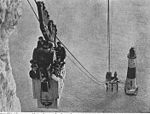Beachy Head Lighthouse
 | |
 | |
| Location | Eastbourne East Sussex England |
|---|---|
| OS grid | TV5827495078 |
| Coordinates | 50°44′02″N 0°14′29″E / 50.733791°N 0.241478°E |
| Tower | |
| Constructed | 1902 |
| Foundation | concrete base |
| Construction | granite tower |
| Automated | 1983 |
| Height | 43 m (141 ft) |
| Shape | tapered cylindrical with balcony and lantern |
| Markings | white tower with a broad horizontal red band, red lantern |
| Operator | Trinity House[2] |
| Heritage | Grade II listed building |
| Fog signal | blast every 30s. (Discontinued 2011) |
| Light | |
| Focal height | 31 m (102 ft) |
| Lens | First Order 920 mm Asymmetrical Catadioptric rotating optic |
| Range | 8 nmi (15 km; 9.2 mi)[1] |
| Characteristic | Fl (2) W 20s. |
Beachy Head Lighthouse is a lighthouse located in the English Channel below Beachy Head in East Sussex. It is 43 m (141 ft) in height and became operational in October 1902.[3]
Construction
In 1900 to 1902 under the direction of Sir Thomas Matthews, the Trinity House Engineer-in-Chief, the lighthouse was built, sited about 165 metres seawards from the base of the cliffs. For the construction, a temporary cable car from the cliff was installed for the transport of workers and stones to an iron ocean platform adjacent to the lighthouse. 3,660 tons of Cornish granite were used in the construction of the tower.
Operation
For more than 80 years, the red-and-white striped tower was manned by three lighthouse keepers. Their job was to maintain the light, which rotates, making two white flashes every 20 seconds. It was then visible 26 nautical miles (48 km; 30 mi) out to sea. The lighthouse was fully automated in 1983 and the keepers withdrawn.
In June 2010, Trinity House announced in the five yearly "Aids To Navigation Review" that the light range would be reduced to 8 nmi (15 km; 9.2 mi) and the fog signal discontinued. In February 2011, the work was undertaken and light range reduced by the installation of a new LED navigation light system. The old lens, though no longer in use, was left in situ. The fog signal was also discontinued at this time.
Trinity House announced in 2011 that it could no longer afford to repaint the distinctive red and white stripes and that it would have to be left to return to its natural granite gray. It stated that because boats now have high tech navigational systems the day marker stripes are no longer essential. However, a sponsored campaign to keep the stripes was launched in October 2011. The required £27,000 was raised.[4] The tower repainting was completed in October using a team including two abseilers. Five coats of paint were applied to the copper lantern at the top and three on each hoop of the tower.[5]
Gallery
-
Looking towards the cliffs and lighthouse from the west near Birling Gap
-
Temporary cable car for the construction of the lighthouse
-
The lighthouse from the sea
-
The lighthouse from the east side
-
Detail of the lighthouse
In popular culture
The lighthouse was a setting in an episode of The Prisoner called The Girl Who Was Death.
See also
References
- ^ List of Lights, Pub. 114: British Isles, English Channel and North Sea (PDF). List of Lights. United States National Geospatial-Intelligence Agency. 2015.
- ^ Beachy Head The Lighthouse Directory. University of North Carolina at Chapel Hill. Retrieved 29 April 2016
- ^ Surtees, Dr John (1997). Beachy Head. Seaford: SB Publications. ISBN 1-85770-118-6.
- ^ "Beachy Head Lighthouse Campaign". Beachy Head Lighthouse Campaign.
{{cite web}}: Cite has empty unknown parameter:|coauthors=(help) - ^ "Beachy Head lighthouse repainting 'finishing touches'". BBC.
{{cite web}}: Cite has empty unknown parameter:|coauthors=(help)





